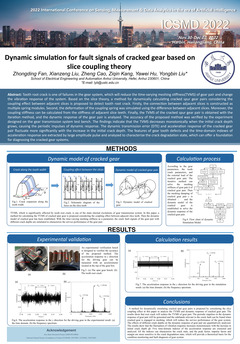Dynamic simulation for fault signals of cracked gear based on slice coupling theory
ID:21
View Protection:PUBLIC
Updated Time:2022-12-20 14:58:29
Hits:714
Poster Presentation
Abstract
Tooth root crack is one of failures in the gear system, which will reduce the time-varying meshing stiffness(TVMS) of gear pair and change the vibration response of the system. Based on the slice theory, a method for dynamically calculating cracked spur gear pairs considering the coupling effect between adjacent slices is proposed to detect tooth root crack. Firstly, the connection between adjacent slices is constructed as multiple spring modules. Second, the deformation of the coupling spring was simulated using the difference between adjacent slices. Moreover, the coupling stiffness can be calculated from the stiffness of adjacent slice teeth. Finally, the TVMS of the cracked spur gear pair is obtained with the iteration method, and the dynamic response of the gear pair is analyzed. The accuracy of the proposed method was verified by the experiment designed on the gear transmission system test bench. The findings indicate that the TVMS decreases monotonically when the initial crack depth grows, causing the periodic impulses of dynamic response. The dynamic transmission error (DTE) and acceleration response of the cracked gear pair fluctuate more significantly with the increase in the initial crack depth. The features of gear tooth defects and the time-domain indexes of acceleration response are extracted by large amplitude pulse and analyzed to characterize the crack degradation state, which can offer a foundation for diagnosing the cracked gear systems.
Keywords
Time-varying meshing stiffness;Tooth root cracks;Slice coupling;Slice theory;Time-domain indexes



Comment submit